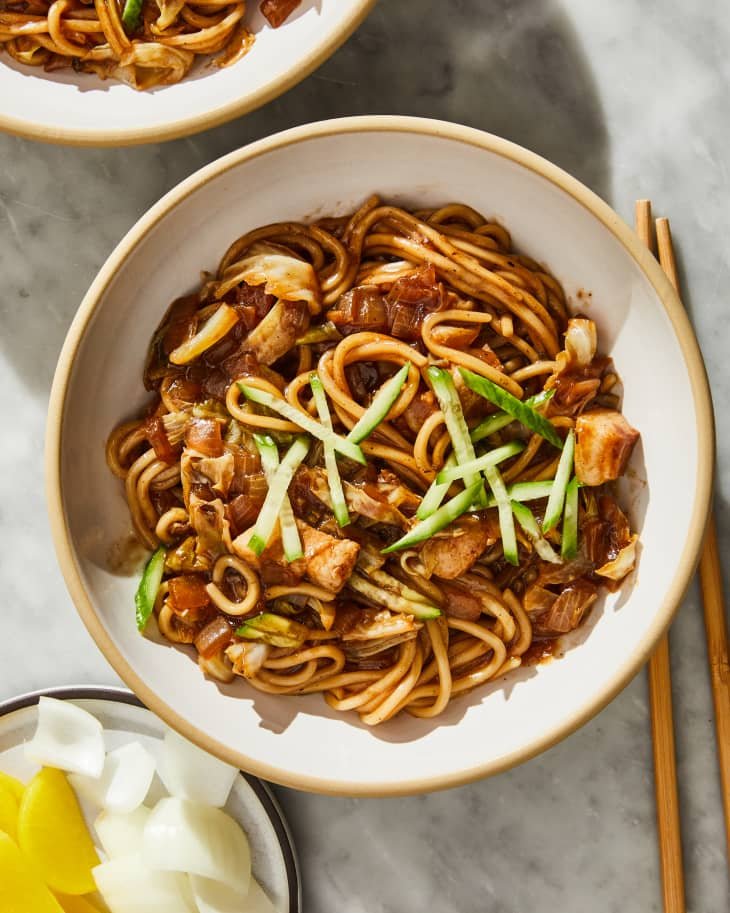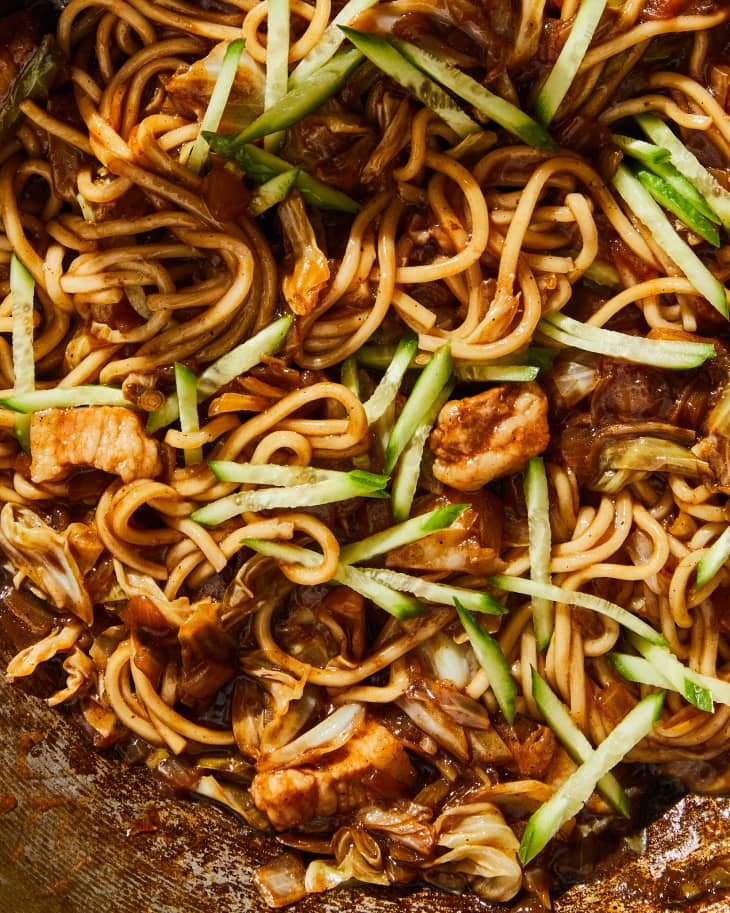Jjajangmyeon (Korean Black Bean Noodles)
When I was growing up in Korea, jjajangmyeon was one of my go-to choices when my parents took me out for dinner. I was fascinated by the look of jet-black, gravy-like sauce on top of hand-pulled noodles, and as soon as I got my bowl, I slurped the saucy noodles as if I was going to inhale them in one bite. Whether it was for a moving day, a graduation, or a birthday party, I always found reasons to slurp jjajangmyeon.
I’ve tried many different recipes to mimic the flavors of jjajangmyeon that I fell in love with as a child. I remember there weren’t many vegetables in the sauce, mostly cabbage and onions. But there were large chunks of pork in the sauce, and it had a rich, thick consistency, almost like a chocolate hot fudge sauce.
This jjajangmyeon is a nearly perfect recreation of my childhood dream dish, with a few twists. It’s intensely savory, comforting, and perfectly slurpable.
What Is Jjajangmyeon?
Jjajangmyeon is a popular Korean-Chinese noodle dish that’s made out of jjajang sauce and fresh noodles, often hand-pulled. It was originally inspired by the Chinese dish, zha jiang mian, but the Chinese immigrants modified the flavors and techniques to meet Korean preferences. The current form of jjajangmyeon was developed in Incheon Chinatown in the 1910s.
Jjajangmyeon is very savory, deliciously salty, mildly sweet, and pleasantly earthy at the end. It can be a bit greasy, so pickled yellow radish is usually paired with the dish to cut through the sauce’s richness.
INGREDIENTS
1/2 medium green cabbage (about 10 ounces)
2 medium yellow onions
4 medium scallions
1/4 cup vegetable oil
8 ounces unsliced boneless, skinless pork belly or fatty pork loin
1 (1-inch) piece peeled ginger
1/4 cup Korean black bean paste (chunjang or jjajang)
1 tablespoon plus 1 1/2 teaspoons granulated sugar
1 tablespoon oyster sauce
1 tablespoon soy sauce
1 1/2 teaspoons chicken bouillon powder
1 3/4 cups water, divided
2 tablespoons potato starch or cornstarch
1 medium Persian cucumber
1 teaspoon apple cider vinegar
7 ounces fresh wheat noodles for jjajangmyeon or 2 ounces dried noodles
Instructions
Prepare the following, adding each to the same medium bowl as it is complete: Cut the core from 1/2 medium green cabbage; cut the leaves into 1-inch pieces until you have about 3 cups. Dice 2 medium yellow onions (about 3 cups) Finely chop 4 medium scallions (about 2/3 cup).
Heat 1/4 cup vegetable oil in a large heavy-bottomed pot or wok over medium heat until shimmering. Add the cabbage mixture and cook until the onions look translucent and the cabbage starts to brown in spots, 4 to 6 minutes. Meanwhile, cut 8 ounces pork belly or pork loin into 1-inch pieces. Peel and mince 1 (1-inch) piece ginger (about 1 tablespoon).
Add the pork and ginger and cook until the pork is no longer pink, 3 to 5 minutes. Make a well in the center by pushing everything to the sides. Add 1/4 cup Korean black bean paste to the well and use a spatula to stir-fry the paste in the pool of oil. Mix into the vegetables and cook until glossy and the vegetables are well coated, 3 to 5 minutes.
Add 1 tablespoon plus 1 1/2 teaspoons granulated sugar, 1 tablespoon oyster sauce, 1 tablespoon soy sauce, and 1 1/2 teaspoons chicken bouillon powder. Stir-fry until everything is well incorporated, 1 to 2 minutes.
Add 1 1/2 cups of the water and stir to combine. Simmer, stirring occasionally, until the liquid is slightly thickened, 8 to 10 minutes. Meanwhile, place the remaining 1/4 cup water and 2 tablespoons potato starch or cornstarch in a small bowl and stir until the starch is dissolved. Bring a large pot of water to a boil over medium-high heat. Cut 1 medium Persian cucumber into matchsticks.
While stirring constantly, add the starch mixture and simmer until the liquid thickens to the consistency of a thick gravy, 2 to 3 minutes. Add 1 teaspoon apple cider vinegar and stir to combine. Remove the pot from the heat.
Add 7 ounces fresh jjajangmyeon noodles (or 2 ounces dried) to the boiling water and cook according to the package instructions. Drain, rinse, and transfer the noodles to 2 to 3 individual serving bowls. Top with the sauce and garnish with the cucumber. Toss before serving.
RECIPE NOTES
Make ahead: The sauce can be made up to 3 days in advance and refrigerated in an airtight container. Reheat over low heat and pour it over freshly cooked noodles.
Storage: It’s best to keep leftover sauce and noodles separate if you can. Refrigerate in airtight containers for up to 5 days.


